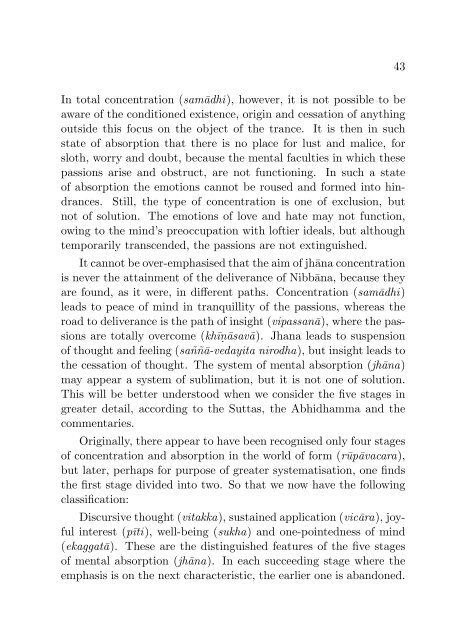Agony and Ecstasy
A comparative study of the five hindrances, together with the five states of concentration or mental absorption.
A comparative study of the five hindrances, together with the five states of concentration or mental absorption.
You also want an ePaper? Increase the reach of your titles
YUMPU automatically turns print PDFs into web optimized ePapers that Google loves.
43<br />
In total concentration (samādhi), however, it is not possible to be<br />
aware of the conditioned existence, origin <strong>and</strong> cessation of anything<br />
outside this focus on the object of the trance. It is then in such<br />
state of absorption that there is no place for lust <strong>and</strong> malice, for<br />
sloth, worry <strong>and</strong> doubt, because the mental faculties in which these<br />
passions arise <strong>and</strong> obstruct, are not functioning. In such a state<br />
of absorption the emotions cannot be roused <strong>and</strong> formed into hindrances.<br />
Still, the type of concentration is one of exclusion, but<br />
not of solution. The emotions of love <strong>and</strong> hate may not function,<br />
owing to the mind’s preoccupation with loftier ideals, but although<br />
temporarily transcended, the passions are not extinguished.<br />
It cannot be over-emphasised that the aim of jhāna concentration<br />
is never the attainment of the deliverance of Nibbāna, because they<br />
are found, as it were, in different paths. Concentration (samādhi)<br />
leads to peace of mind in tranquillity of the passions, whereas the<br />
road to deliverance is the path of insight (vipassanā), where the passions<br />
are totally overcome (khīṇāsavā). Jhana leads to suspension<br />
of thought <strong>and</strong> feeling (saññā-vedayita nirodha), but insight leads to<br />
the cessation of thought. The system of mental absorption (jhāna)<br />
may appear a system of sublimation, but it is not one of solution.<br />
This will be better understood when we consider the five stages in<br />
greater detail, according to the Suttas, the Abhidhamma <strong>and</strong> the<br />
commentaries.<br />
Originally, there appear to have been recognised only four stages<br />
of concentration <strong>and</strong> absorption in the world of form (rūpāvacara),<br />
but later, perhaps for purpose of greater systematisation, one finds<br />
the first stage divided into two. So that we now have the following<br />
classification:<br />
Discursive thought (vitakka), sustained application (vicāra), joyful<br />
interest (pīti), well-being (sukha) <strong>and</strong> one-pointedness of mind<br />
(ekaggatā). These are the distinguished features of the five stages<br />
of mental absorption (jhāna). In each succeeding stage where the<br />
emphasis is on the next characteristic, the earlier one is ab<strong>and</strong>oned.

















